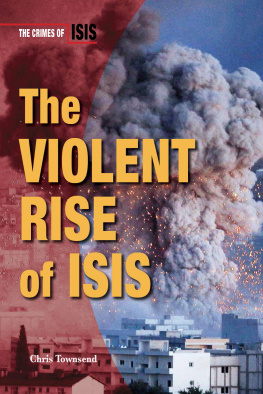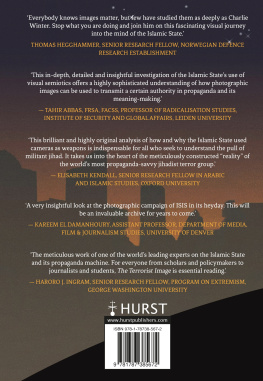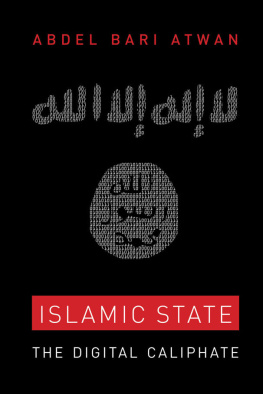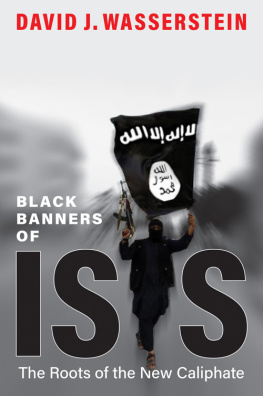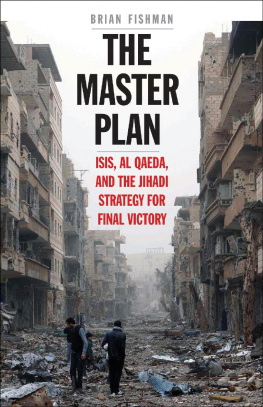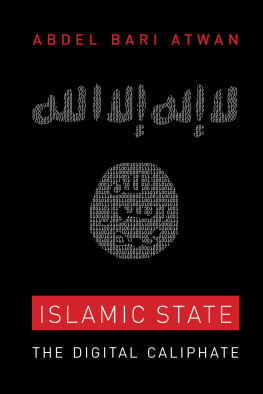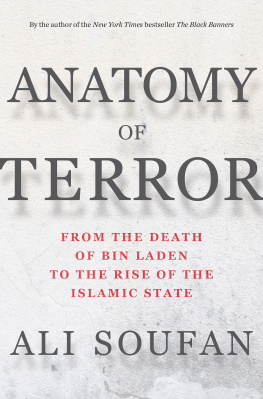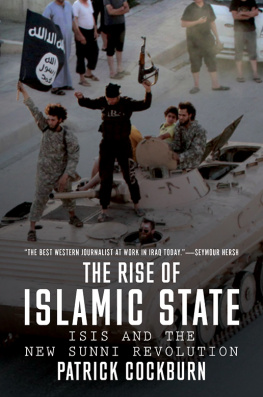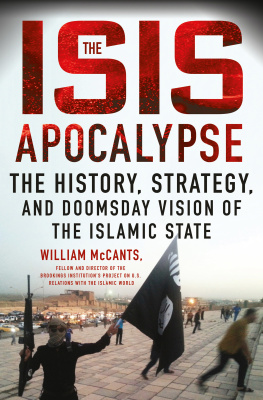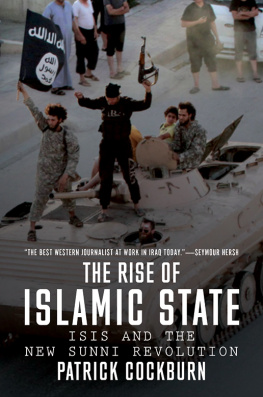THE MASTER PLAN
BRIAN H. FISHMAN
The Master Plan
ISIS, AL-QAEDA, AND THE JIHADI STRATEGY FOR FINAL VICTORY

Copyright 2016 by Brian H. Fishman.
All rights reserved.
This book may not be reproduced, in whole or in part, including illustrations, in any form (beyond that copying permitted by Sections 107 and 108 of the U.S. Copyright Law and except by reviewers for the public press), without written permission from the publishers.
Yale University Press books may be purchased in quantity for educational, business, or promotional use. For information, please e-mail (U.K. office).
Set in Scala type by Westchester Publishing Services.
Printed in the United States of America.
Library of Congress Control Number: 2016944655
ISBN 978-0-300-22149-7 (hardcover : alk. paper)
A catalogue record for this book is available from the British Library.
This paper meets the requirements of ANSI/NISO Z39.48-1992 (Permanence of Paper).
10 9 8 7 6 5 4 3 2 1
To the children of war, who have seen more than they should
CONTENTS
PREFACE
THE ATTACKS CAME IN QUICK SUCCESSION ACROSS the globe. On Metrojet Flight 7K9268 from the Egyptian resort town of Sharm el-Sheikh to Saint Petersburg, Russia, a bomb tore through the planes skin, rapidly depressurizing the cabin and killing all 224 people on board. Three weeks later, a double suicide bombing in a Beirut neighborhood dominated by Shia Muslims killed forty-three people. The following night, a multi-pronged attack in Paris killed 130 people, many inside a local concert hall.
All of those attacks were claimed by the Islamic State, which in late 2015 controlled a swath of territory in Iraq and Syria the size of the United Kingdom, containing a population of more than six million people, and collecting revenue of approximately $80 million per month. The Islamic State called itself the Caliphate, with supposed religious and political authority over every Muslim on earth. It enforced that grandiose vision by brutally killing anyone in its way, most of whom were Muslims the Caliphate disavowed as apostates. Islamic State provinces sprung up in Libya, Egypt, Afghanistan, Nigeria, and beyond, ensuring that destroying the group would take years, if not decades. No government on earth recognized the Islamic State as a sovereign entity, but the most dangerous terrorist organization in the world was, de facto, its own country.
For many in the West, the Islamic States emergence as a global force was a surprise. It seemed to come from nowhere in the cauldron of the Syrian civil war and immediately transform into a global threat.
But the Islamic State did not emerge from nowhere. The Islamic States leaders celebrated the institutions tenth anniversary in June 2016, identifying its founding in October 2006. And even prior to that, a senior al-Qaeda leader living under a permissive form of house arrest in Iran framed a seven-stage master plan that began with the 9/11 attacks and called for the declaration of a caliphate in Syria between 2013 and 2016. If not a blueprint for events to come, the proposal has proved a startlingly prescient prediction of future events.
There are many ways to tell the history of the Islamic State: as an ideological movement, as a product of the Syrian civil war, as part of a broader social backlash against the century-old division of the Middle East into modern nation states. All of these lenses have their own value, and the rise of Zarqawiism as a distinct strain of jihadi thought deserves particular attention.
At its core, however, this book is not a history of ideas; it is a history of people and the strategic and operational decisions they made to create the Islamic State. Zarqawiism is a dystopian cultural movement wrapped around a core set of ideological principles. Those ideological principles are obviously critical, but they should not be removed from the people that conceived and implemented them. Ideas are dangerous, but they do not kill en masse until human beings build organizations to implement them.
Indeed, the importance of jihadi strategy is often overlooked. The master plan that predicted the caliphate would be reestablished in Syria between 2013 and 2016 was the best guide to the Islamic States future development, but it was not, primarily, an ideological document. Although it was a nod to religious prophecy and was designed to pursue jihadi ideological goals, the master plan was a strategy document not so different from those developed by all sorts of military and political organizations. The end state to be achieved was a function of ideology, but the heart of the master plan was simply a blueprint to get from here to there.
The old clich about military plans is that they never survive first contact with the enemy. The master plan has proved extremely accurate in some respects, but it is far from perfect. The point of planning, however, is not so much to develop a perfect scheme for action, but to identify critical decision points, risks, and benchmarks. By that standard, the master plan has succeeded brilliantly.
This book is the history of the people who built the Islamic State by implementing elements of that master plan and rejecting others. It also lays a foundation for understanding the Islamic States future. After all, the master plans initial vision was not simply to declare the caliphate. After the caliphate was declared, the plan promised a campaign of terrorism like none the world had ever seen, and a jihadi final victory by 2020. The Islamic State is increasingly on the defensive in Iraq and Syria, but according to the master plan, the worst is yet to come.
ACKNOWLEDGMENTS
THIS BOOK BEGAN AS THE SYLLABUS FOR AN Advanced Terrorism seminar I taught on the Islamic State of Iraq at the United States Military Academy in 2008. That course was based on research I began at West Points Combating Terrorism Center (CTC) in 2005. This means, among other things, that I have a decades worth of people to thank.
First, I owe a great debt to all of my colleagues at the CTC. Thank you to Jarret Brachman, Jeff Bramlett, Bill Braniff, Vahid Brown, James Forest, Alex Gallo, Scott Helfstein, Lianne Kennedy-Boudali, Will McCants, Kip McCormick, Afshon Ostovar, Don Rassler, Reid Sawyer (who recruited me), Jake Shapiro, Thalia Tzanetti, and Clint Watts. Their influenceformally cited and otherwiseis all over this book.
The leadership of the CTC and the SOSH Department at West Point created a wonderful environment in which to learn and work. Thanks to General Russell Howard, General Michael Meese, and General Cindy Jebb. Ambassador Mike Sheehan, Bruce Hoffman, General Wayne Downing, and General John Abizaid offered guidance and inspiration. A special thanks to Colonel Joe Felter, a friend, mentor, traveling partner in two war zones, and co-author for more than a decade.
The CTC functioned only because of donor support. I am thankful to everyone who supported our work, but particularly Vinnie Viola, a West Point graduate.
After leaving the CTC, I landed at New America, a think tank in Washington, D.C., where I tracked the resurrection of the Islamic State of Iraq in late 2010 and 2011. Thanks to Peter Bergen, Steve Coll, Katherine Tiedemann, Andrew Liebovich, and Jennifer Rowland.
I am grateful to the various individuals and institutions that have offered me an organizational home during the writing of this book. To Peter Bergen at New America, Bryan Price at West Points CTC, Amy Zegart at Stanfords Center for International Security and Cooperation, and Lawrence Rosenthal at UC Berkeleys Center for Right-Wing Studies, thank you.
Next page







